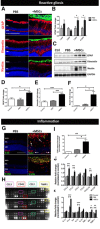Molecular Mechanisms Mediating Retinal Reactive Gliosis Following Bone Marrow Mesenchymal Stem Cell Transplantation
- PMID: 26175331
- PMCID: PMC4832383
- DOI: 10.1002/stem.2095
Molecular Mechanisms Mediating Retinal Reactive Gliosis Following Bone Marrow Mesenchymal Stem Cell Transplantation
Abstract
A variety of diseases lead to degeneration of retinal ganglion cells (RGCs) and their axons within the optic nerve resulting in loss of visual function. Although current therapies may delay RGC loss, they do not restore visual function or completely halt disease progression. Regenerative medicine has recently focused on stem cell therapy for both neuroprotective and regenerative purposes. However, significant problems remain to be addressed, such as the long-term impact of reactive gliosis occurring in the host retina in response to transplanted stem cells. The aim of this work was to investigate retinal glial responses to intravitreally transplanted bone marrow mesenchymal stem cells (BM-MSCs) to help identify factors able to modulate graft-induced reactive gliosis. We found in vivo that intravitreal BM-MSC transplantation is associated with gliosis-mediated retinal folding, upregulation of intermediate filaments, and recruitment of macrophages. These responses were accompanied by significant JAK/STAT3 and MAPK (ERK1/2 and JNK) cascade activation in retinal Muller glia. Lipocalin-2 (Lcn-2) was identified as a potential new indicator of graft-induced reactive gliosis. Pharmacological inhibition of STAT3 in BM-MSC cocultured retinal explants successfully reduced glial fibrillary acidic protein expression in retinal Muller glia and increased BM-MSC retinal engraftment. Inhibition of stem cell-induced reactive gliosis is critical for successful transplantation-based strategies for neuroprotection, replacement, and regeneration of the optic nerve.
Keywords: Glia; Mesenchymal stem cells; Retina; Stem cell transplantation.
© 2015 The Authors. STEM CELLS Published by Wiley Periodicals, Inc. on behalf of AlphaMed Press.
Figures





References
-
- Levin LA. Axonal loss and neuroprotection in optic neuropathies. Can J Ophthalmol 2007;42:403–408. - PubMed
Publication types
MeSH terms
Grants and funding
LinkOut - more resources
Full Text Sources
Other Literature Sources
Molecular Biology Databases
Research Materials
Miscellaneous

